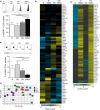Human CD8+ EMRA T cells display a senescence-associated secretory phenotype regulated by p38 MAPK
- PMID: 29024417
- PMCID: PMC5770853
- DOI: 10.1111/acel.12675
Human CD8+ EMRA T cells display a senescence-associated secretory phenotype regulated by p38 MAPK
Abstract
Cellular senescence is accompanied by a senescence-associated secretory phenotype (SASP). We show here that primary human senescent CD8+ T cells also display a SASP comprising chemokines, cytokines and extracellular matrix remodelling proteases that are unique to this subset and contribute to age-associated inflammation. We found the CD8+ CD45RA+ CD27- EMRA subset to be the most heterogeneous, with a population aligning with the naïve T cells and another with a closer association to the effector memory subset. However, despite the differing processes that give rise to these senescent CD8+ T cells once generated, they both adopt a unique secretory profile with no commonality to any other subset, aligning more closely with senescence than quiescence. Furthermore, we also show that the SASP observed in senescent CD8+ T cells is governed by p38 MAPK signalling.
Keywords: SASP; T cell; aging; cytokine; inflammation; microarray.
© 2017 The Authors. Aging Cell published by the Anatomical Society and John Wiley & Sons Ltd.
Figures




References
-
- Akbar AN, Henson SM (2011) Are senescence and exhaustion intertwined or unrelated processes that compromise immunity? Nat. Rev. Immunol. 11, 289–295. - PubMed
-
- Akbar AN, Henson SM, Lanna A (2016) Senescence of T lymphocytes: implications for enhancing human immunity. Trends Immunol. 37, 866–876. - PubMed
-
- Aoshiba K, Tsuji T, Kameyama S, Itoh M, Semba S, Yamaguchi K, Nakamura H (2013) Senescence‐associated secretory phenotype in a mouse model of bleomycin‐induced lung injury. Exp. Toxicol. Pathol. 65, 1053–1062. - PubMed
-
- Bridges LC, Tani PH, Hanson KR, Roberts CM, Judkins MB, Bowditch RD (2002) The lymphocyte metalloprotease MDC‐L (ADAM 28) is a ligand for the integrin α4β1. J. Biol. Chem. 277, 3784–3792. - PubMed
-
- Campisi J (2005) Senescent cells, tumor suppression, and organismal aging: good citizens, bad neighbors. Cell 120, 513–522. - PubMed
Publication types
MeSH terms
Substances
Grants and funding
- BB/J006750/1/BB_/Biotechnology and Biological Sciences Research Council/United Kingdom
- MR/P00184X/1/MRC_/Medical Research Council/United Kingdom
- MR/M003833/1/MRC_/Medical Research Council/United Kingdom
- BBS/B/04528/BB_/Biotechnology and Biological Sciences Research Council/United Kingdom
- MR/N017749/1/MRC_/Medical Research Council/United Kingdom
LinkOut - more resources
Full Text Sources
Other Literature Sources
Molecular Biology Databases
Research Materials

